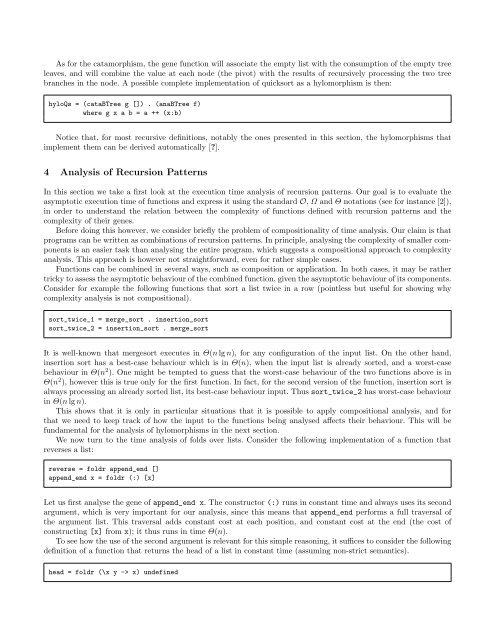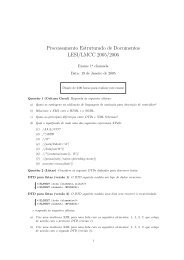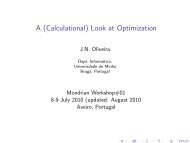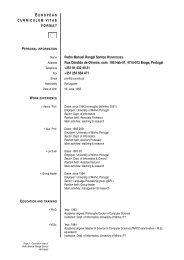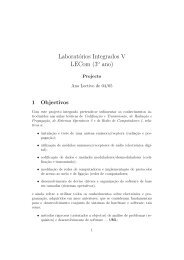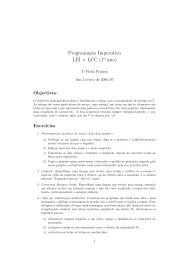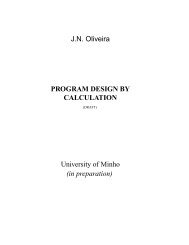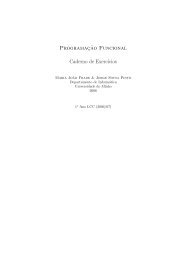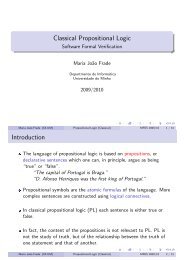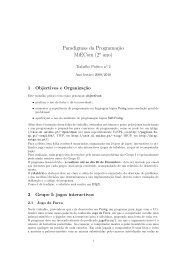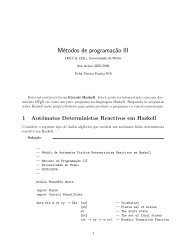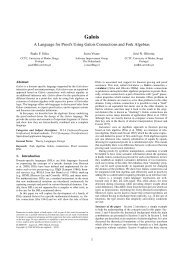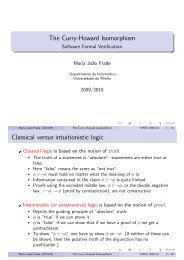Recursion Patterns and Time-analysis - Departamento de ...
Recursion Patterns and Time-analysis - Departamento de ...
Recursion Patterns and Time-analysis - Departamento de ...
Create successful ePaper yourself
Turn your PDF publications into a flip-book with our unique Google optimized e-Paper software.
As for the catamorphism, the gene function will associate the empty list with the consumption of the empty treeleaves, <strong>and</strong> will combine the value at each no<strong>de</strong> (the pivot) with the results of recursively processing the two treebranches in the no<strong>de</strong>. A possible complete implementation of quicksort as a hylomorphism is then:hyloQs = (cataBTree g []) . (anaBTree f)where g x a b = a ++ (x:b)Notice that, for most recursive <strong>de</strong>finitions, notably the ones presented in this section, the hylomorphisms thatimplement them can be <strong>de</strong>rived automatically [?].4 Analysis of <strong>Recursion</strong> <strong>Patterns</strong>In this section we take a first look at the execution time <strong>analysis</strong> of recursion patterns. Our goal is to evaluate theasymptotic execution time of functions <strong>and</strong> express it using the st<strong>and</strong>ard O, Ω <strong>and</strong> Θ notations (see for instance [2]),in or<strong>de</strong>r to un<strong>de</strong>rst<strong>and</strong> the relation between the complexity of functions <strong>de</strong>fined with recursion patterns <strong>and</strong> thecomplexity of their genes.Before doing this however, we consi<strong>de</strong>r briefly the problem of compositionality of time <strong>analysis</strong>. Our claim is thatprograms can be written as combinations of recursion patterns. In principle, analysing the complexity of smaller componentsis an easier task than analysing the entire program, which suggests a compositional approach to complexity<strong>analysis</strong>. This approach is however not straightforward, even for rather simple cases.Functions can be combined in several ways, such as composition or application. In both cases, it may be rathertricky to assess the asymptotic behaviour of the combined function, given the asymptotic behaviour of its components.Consi<strong>de</strong>r for example the following functions that sort a list twice in a row (pointless but useful for showing whycomplexity <strong>analysis</strong> is not compositional).sort_twice_1 = merge_sort . insertion_sortsort_twice_2 = insertion_sort . merge_sortIt is well-known that mergesort executes in Θ(n lg n), for any configuration of the input list. On the other h<strong>and</strong>,insertion sort has a best-case behaviour which is in Θ(n), when the input list is already sorted, <strong>and</strong> a worst-casebehaviour in Θ(n 2 ). One might be tempted to guess that the worst-case behaviour of the two functions above is inΘ(n 2 ), however this is true only for the first function. In fact, for the second version of the function, insertion sort isalways processing an already sorted list, its best-case behaviour input. Thus sort_twice_2 has worst-case behaviourin Θ(n lg n).This shows that it is only in particular situations that it is possible to apply compositional <strong>analysis</strong>, <strong>and</strong> forthat we need to keep track of how the input to the functions being analysed affects their behaviour. This will befundamental for the <strong>analysis</strong> of hylomorphisms in the next section.We now turn to the time <strong>analysis</strong> of folds over lists. Consi<strong>de</strong>r the following implementation of a function thatreverses a list:reverse = foldr append_end []append_end x = foldr (:) [x]Let us first analyse the gene of append_end x. The constructor (:) runs in constant time <strong>and</strong> always uses its secondargument, which is very important for our <strong>analysis</strong>, since this means that append_end performs a full traversal ofthe argument list. This traversal adds constant cost at each position, <strong>and</strong> constant cost at the end (the cost ofconstructing [x] from x); it thus runs in time Θ(n).To see how the use of the second argument is relevant for this simple reasoning, it suffices to consi<strong>de</strong>r the following<strong>de</strong>finition of a function that returns the head of a list in constant time (assuming non-strict semantics).head = foldr (\x y -> x) un<strong>de</strong>fined


